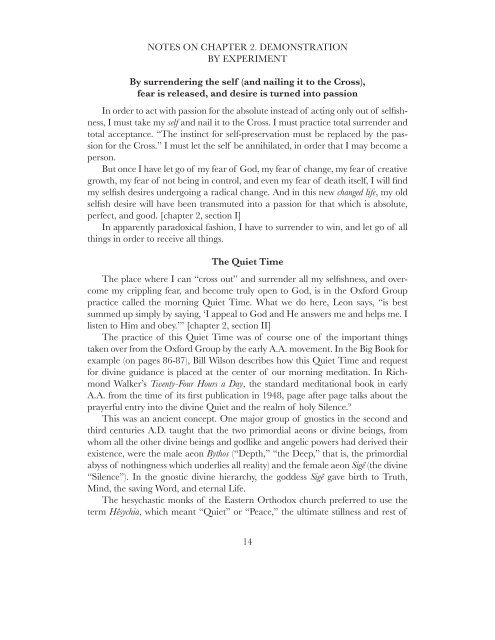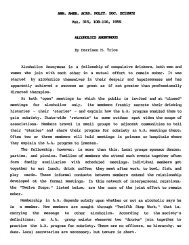NOTES ON CHAPTER 2. DEMONSTRATIONBY EXPERIMENTBy surrendering the self (and nailing it to the Cross),fear is released, and desire is turned into passionIn order to act with passion for the absolute instead <strong>of</strong> acting only out <strong>of</strong> selfishness,I must take my self and nail it to the Cross. I must practice total surrender andtotal acceptance. “<strong>The</strong> instinct for self-preservation must be replaced by the passionfor the Cross.” I must let the self be annihilated, in order that I may become aperson.But once I have let go <strong>of</strong> my fear <strong>of</strong> God, my fear <strong>of</strong> change, my fear <strong>of</strong> creativegrowth, my fear <strong>of</strong> not being in control, and even my fear <strong>of</strong> death itself, I will findmy selfish desires undergoing a radical change. And in this new changed life, my oldselfish desire will have been transmuted into a passion for that which is absolute,perfect, and good. [chapter 2, section I]In apparently paradoxical fashion, I have to surrender to win, and let go <strong>of</strong> allthings in order to receive all things.<strong>The</strong> Quiet Time<strong>The</strong> place where I can “cross out” and surrender all my selfishness, and overcomemy crippling fear, and become truly open to God, is in the Oxford Grouppractice called the morning Quiet Time. What we do here, Leon says, “is bestsummed up simply by saying, ‘I appeal to God and He answers me and helps me. Ilisten to Him and obey.’” [chapter 2, section II]<strong>The</strong> practice <strong>of</strong> this Quiet Time was <strong>of</strong> course one <strong>of</strong> the important thingstaken over from the Oxford Group by the early A.A. movement. In the Big Book forexample (on pages 86-87), Bill Wilson describes how this Quiet Time and requestfor divine guidance is placed at the center <strong>of</strong> our morning meditation. In RichmondWalker’s Twenty-Four Hours a Day, the standard meditational book in earlyA.A. from the time <strong>of</strong> its first publication in 1948, page after page talks about theprayerful entry into the divine Quiet and the realm <strong>of</strong> holy Silence. 9This was an ancient concept. One major group <strong>of</strong> gnostics in the second andthird centuries A.D. taught that the two primordial aeons or divine beings, fromwhom all the other divine beings and godlike and angelic powers had derived theirexistence, were the male aeon Bythos (“Depth,” “the Deep,” that is, the primordialabyss <strong>of</strong> nothingness which underlies all reality) and the female aeon Sigê (the divine“Silence”). In the gnostic divine hierarchy, the goddess Sigê gave birth to Truth,Mind, the saving Word, and eternal Life.<strong>The</strong> hesychastic monks <strong>of</strong> the Eastern Orthodox church preferred to use theterm Hêsychia, which meant “Quiet” or “Peace,” the ultimate stillness and rest <strong>of</strong>14
perfect serenity. By shutting <strong>of</strong>f all their disrupting thoughts and concerns, and allowingtheir minds to float wordlessly within this realm <strong>of</strong> peace and quiet, theyfound that they could eventually experience the divine Uncreated Light in an experiencesimilar to the one which Bill Wilson had in Towns Hospital in the middle <strong>of</strong>December 1934, after he had had his last drink. 10Guidance and the great TerrorAlthough it is called the Quiet Time, whenever I ask God for guidance, that is,when I ask him what it is that I am to do today, God’s answer may at first plungeme, not into rest and peace, but into fear and revulsion. What I am asked to do mayeven plunge me head over heels into the great Terror. Sometimes the act <strong>of</strong> servicewhich God asks me to perform seems to involve me losing all <strong>of</strong> my worldly goods,my reputation, and even my life. At other times I may feel God requesting me tomake an apology or carry out an amends, in a context which may be quite minorat one level, but which would make me feel totally humiliated. If I have been a personwho has been too ambitious and hard driving, and who has worried too muchabout everything, God’s guidance may even tell me that I need to start relaxing andtaking things easy for a while. In the case <strong>of</strong> people who feel as though they haveto be busy, busy, busy all the time, that can throw them into what can sometimes beunbelievable terror and rebellion! Me, just sit down and relax? But such-and-suchneeds doing, and such-and-such absolutely has to be done!But whatever it is that God will guide me to do in this moment <strong>of</strong> Quiet Time,it will ask me to carry out the “suicide or the annihilation <strong>of</strong> the self.” And at thatpoint, my natural human tendency will be to reject the Cross, and cry out that thishorrid thing which is confronting me could not be God. [chapter 2, section I]When alcoholics have to face God for the first time, what these alcoholics seedoes not seem like God at all to them. What they in fact see is the horrible face <strong>of</strong>their own alcoholism. <strong>The</strong>y see the wasted ruin <strong>of</strong> their own lives, and all the catastrophesand failures that have dragged them down, and they cry out that not onlyis this not God, this is pro<strong>of</strong> positive that God does not exist. Or if God does exist,then he is hateful and evil. This is the biggest problem which alcoholics face whenthey first enter the twelve step program: the overwhelming fear (“the great Terror”as Philip Leon calls it) which sweeps over them the minute the meeting begins talkingabout God.Perhaps what they see is not God per se—that is true—but it is God’s Cross, thecross to which they must surrender their old lives before they can receive the NewLife. We do not have to put this in Christian terms. We can go back to the Old Testament,and notice how Moses, when he was standing at the bottom <strong>of</strong> Mount Sinai,saw its top covered only with a black storm cloud. Yet the guidance he receivedfrom God told him to start climbing that mountain, right up into the darkness andfear. It was only after he reached the top, that Moses stepped out into the realm15
- Page 1 and 2: The Philosophyof Courageor The Oxfo
- Page 3 and 4: fear of being creative and being ou
- Page 5 and 6: truly were. There was also a spirit
- Page 7 and 8: Comparison with Bill W. and A.A.on
- Page 9 and 10: I must embrace my own feeling of so
- Page 11 and 12: Alcoholism and addiction asforms of
- Page 13: specifications as to how that is to
- Page 17 and 18: The act of total surrender allows t
- Page 19 and 20: this. But you do not have to be any
- Page 21 and 22: NOTES ON CHAPTER 3. SHARING OR SPRE
- Page 23 and 24: [chapter 3, section II]If I am succ
- Page 25 and 26: NOTES ON CHAPTER 4. CHANGING SOCIET
- Page 27 and 28: The Oxford Group and Alcoholics Ano
- Page 29 and 30: view Press, 2000) 28. “Sick origi
- Page 31 and 32: INTRODUCTIONThe world is going mad,
- Page 33 and 34: TRUE RELIGIONWhy are you cowards, p
- Page 35 and 36: CONTENTSIntroductionTrue Religion31
- Page 37 and 38: to do the same for the term “pixi
- Page 39 and 40: the power which is God or from God.
- Page 41 and 42: God. The reader who is asked to con
- Page 43 and 44: these qualities and on the relation
- Page 45 and 46: y the power of God. But it is not n
- Page 47 and 48: IIMYSELFI AM NOT GODThe objection l
- Page 49 and 50: DISEASE OR FEAR: MANIAWhat is wrong
- Page 51 and 52: impurity which is denoted by the si
- Page 53 and 54: occasions when he is threatened wit
- Page 55 and 56: IIIHEALTH OR PASSIONPURE DESIRESinc
- Page 57 and 58: PASSION AND PARTICULAR DESIRESNot b
- Page 59 and 60: Chapter 2DEMONSTRATION BY EXPERIMEN
- Page 61 and 62: to desire passionately to be health
- Page 63 and 64: Conformity with the commandment aga
- Page 65 and 66:
IITHE CRUCIAL EXPERIMENT ORTHE QUIE
- Page 67 and 68:
and hypocrisy, that judged by absol
- Page 69 and 70:
not meant; that the fool was not as
- Page 71 and 72:
hands I commit my spirit.”With th
- Page 73 and 74:
that God the Highwayman is really a
- Page 75 and 76:
I obey guidance to go and see a man
- Page 77 and 78:
foreseen or seen as I have represen
- Page 79 and 80:
AN ILLUSTRATIONBecause the checking
- Page 81 and 82:
IVTHE QUITE TIME AND THEH WORKING D
- Page 83 and 84:
NEED FOR AN ADEQUATE PSYCHOLOGY OF
- Page 85 and 86:
only to poets. But to judge from on
- Page 87 and 88:
For the first time passion or the r
- Page 89 and 90:
HEAVENWhat I have come to is Heaven
- Page 91 and 92:
For Heaven is now no longer a dream
- Page 93 and 94:
I am contiguous with other selves i
- Page 95 and 96:
expanses of self, seem to be experi
- Page 97 and 98:
IITHE STRATEGY OF THE LARGER SELFGO
- Page 99 and 100:
FEAR CONCEALS FEARNow the procedure
- Page 101 and 102:
exposure of the “universe.” Tru
- Page 103 and 104:
IIITHE STRATEGY AGAINST THE LARGER
- Page 105 and 106:
his own. The miracle of self-consci
- Page 107 and 108:
usiness, for government, for the na
- Page 109 and 110:
and then make him follow its course
- Page 111 and 112:
importance to the Company. However,
- Page 113 and 114:
of smugness, self-satisfaction and
- Page 115 and 116:
PREOCCUPATION WITH SYMPTOMSWhen “
- Page 117 and 118:
channel through which collective gu
- Page 119 and 120:
abyss and the area coincide. It is
- Page 121 and 122:
IVTHE ECONOMIC PROBLEMTHE ECONOMIC
- Page 123 and 124:
that need or greed, and not the cap
- Page 125 and 126:
VPOLITICAL SCIENCEUNCHANGED POLITIC
- Page 127 and 128:
it, by blaming other people instead
- Page 129 and 130:
VIPHILOSOPHY AND ARTTHE SINS OF THE
- Page 131 and 132:
For expression or projection is the
- Page 133 and 134:
DENYING THE SEPARATION BETWEEN THE
- Page 135 and 136:
which the errors are designed to pr
- Page 137 and 138:
A PERSONAL NOTEThe philosophy given
- Page 139 and 140:
the formation of sacred stereotypes















